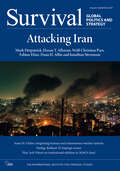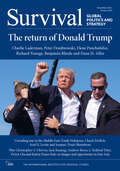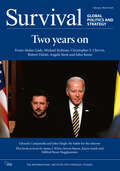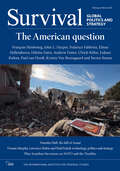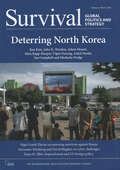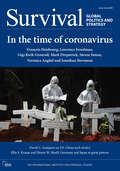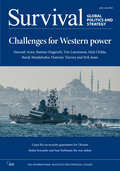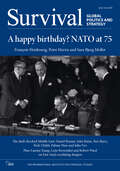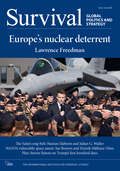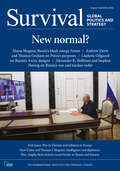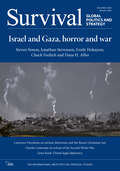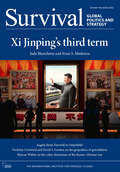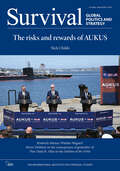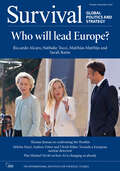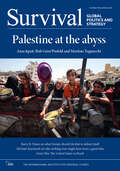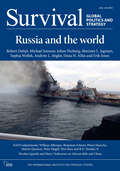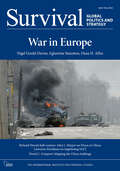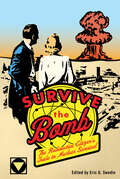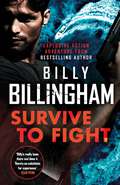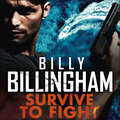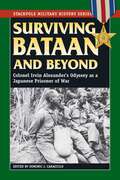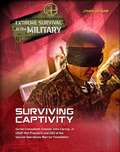- Table View
- List View
Survival: August–September 2025
Survival, the IISS’s bimonthly journal, challenges conventional wisdom and brings fresh, often controversial, perspectives on strategic issues of the moment.In this issue:· Following US and Israeli airstrikes, Mark Fitzpatrick assesses Iran’s residual nuclear capabilities, its freshly intensified resentment and its perceived need to defensively arm itself· Anna M. Gielas argues that humans must be kept actively engaged in artificial-intelligence interfaces used in autonomous warfare to preserve human discretion and cognitive readiness to intervene· Ramon Pacheco Pardo judges that Yoon Suk-yeol’s December 2024 declaration of martial law ultimately served to underscore the resilience of South Korean democracy· Dana H. Allin and Jonathan Stevenson examine the windows of opportunity that precipitated Israel’s strikes on Iran: Israel’s current strategic superiority and a US president disinclined to prevent Israeli action· And nine other thought-provoking pieces, as well as our regular Book Reviews and Noteworthy column.To read free articles from the journal, please visit its homepage at https://www.tandfonline.com/journals/tsur20.Editor: Dr Dana AllinManaging Editor: Jonathan StevensonAssociate Editor: Carolyn WestEditorial Assistant: Anna Gallagher
Survival: December 2024–January 2025
Survival, the IISS’s bimonthly journal, challenges conventional wisdom and brings fresh, often controversial, perspectives on strategic issues of the moment.In this issue: Charlie Laderman discusses the historical precedent for Donald Trump’s threat to shrink the US commitment to NATO: the ‘Great Debate’ of the 1950s Emile Hokayem examines Hizbullah’s future after Hassan Nasrallah’s killing and Israel’s incursion into Lebanon Dana H. Allin analyses what Trump’s return to the White House spells for the world Elene Panchulidze and Richard Youngs discuss Europe’s growing emphasis on supporting democracies as a geopolitical imperative under the shadow of the Russia–Ukraine war And nine more thought-provoking pieces, as well as our regular Book Reviews and Noteworthy column. To read free articles from the journal, please visit its homepage at https://www.tandfonline.com/journals/tsur20.Editor: Dr Dana AllinManaging Editor: Jonathan StevensonAssociate Editor: Carolyn WestEditorial Assistant: Conor Hodges
Survival: February-March 2024
Survival, the IISS’s bimonthly journal, challenges conventional wisdom and brings fresh, often controversial, perspectives on strategic issues of the moment.In this issue: Franz-Stefan Gady and Michael Kofman highlight the pitfalls of grafting a Western manoeuvre-oriented approach to war onto the Russia–Ukraine conflict Irene Mia examines the chasm between Javier Milei’s dramatic rhetoric and the domestic and international obstacles he faces to changing Argentina’s foreign and economic policies Edoardo Campanella and John Haigh outline the necessity of meaningful dialogue between the West and China to prevent the internet’s fragmentation John Raine assesses the geopolitical trends that the Gaza war has set in motion and the issues they create for Ukraine’s defence against Russia And seven more thought-provoking pieces, as well as our regular Book Reviews and Noteworthy column. Editor: Dr Dana AllinManaging Editor: Jonathan StevensonAssociate Editor: Carolyn WestEditorial Assistant: Conor Hodges
Survival: February–March 2025
Survival, the IISS’s bimonthly journal, challenges conventional wisdom and brings fresh, often controversial, perspectives on strategic issues of the moment.In this issue:· François Heisbourg considers the ramifications for Europe of the United States’ potential withdrawal of support for Ukraine· Victor Duenow assesses the effects of Finland’s and Sweden’s NATO membership on the Alliance’s posture and options in the Baltic Sea· Evan A. Laksmana considers the wider implications of increased cooperation between China and Indonesia· Jonathan Stevenson explores how the Republic of Ireland’s membership in NATO could safeguard the Good Friday Agreement and enhance European security· And nine more thought-provoking pieces, as well as our regular Book Reviews and Noteworthy column.To read free articles from the journal, please visit its homepage at https://www.tandfonline.com/journals/tsur20.Editor: Dr Dana AllinManaging Editor: Jonathan StevensonAssociate Editor: Carolyn WestEditorial Assistant: Anna Gallagher
Survival: Global Politics and Strategy (February-March 2020): Deterring North Korea
by Vipin Narang Jina Kim Ian Campbell Mira Rapp-Hooper Ankit Panda John K. Warden Adam Mount Michaela DodgeSurvival, the IISS’s bimonthly journal, challenges conventional wisdom and brings fresh, often controversial, perspectives on strategic issues of the moment.In this issue:Nigel Gould-Davies assesses the impact of Western sanctions on Russia, arguing that they represent a major development in economic statecraft In a special colloquium on the North Korean nuclear threat, Jina Kim, John K. Warden, Adam Mount, Mira Rapp-Hooper, Vipin Narang, Ankit Panda, Ian Campbell and Michaela Dodge offer their ideas for deterring PyongyangAlexander Klimburg warns that CYBERCOM’s strategy of ‘persistent engagement’ is encouraging a cyber arms raceAnd eight more thought-provoking pieces, as well as our regular book reviews and noteworthy column
Survival: In the Time of Coronavirus
by The International Institute for Strategic StudiesSurvival, the IISS’s bimonthly journal, challenges conventional wisdom and brings fresh, often controversial, perspectives on strategic issues of the moment.In this issue:François Heisbourg argues that the COVID-19 pandemic has reinforced the power of the state in its traditional role as protector of society from outside threats Lawrence Freedman assesses that the UK misjudged the speed and severity of the pandemic, but ultimately followed the science Gigi Kwik Gronvall describes the extraordinary global mobilisation of the scientific community as a source of hope amid the pandemicMark Fitzpatrick warns that US sanctions against Iran not only damage America’s reputation, but also violate its moral duty to prevent further deaths of Iranians from COVID-19 And eight more thought-provoking pieces, as well as our regular book reviews and noteworthy column
Survival: June - July 2023
by The International Institute for Strategic StudiesSurvival, the IISS’s bimonthly journal, challenges conventional wisdom and brings fresh, often controversial, perspectives on strategic issues of the moment. In this issue Hannah Aries, Bastian Giegerich and Tim Lawrenson assess that Europe’s defence industry will struggle to meet increased production needs In 2007, the late Ronald Steel judged that while the Iraq War had weakened the United States, it would not profoundly affect US foreign policy (from the archive) Dana H. Allin reflects on Ronald Steel’s legacy and prospects for the ‘extended American Century’ Liana Fix argues that the West should formulate security guarantees for Ukraine in parallel with its counter-offensive Daniel Sobelman assesses that the Yemen-based Houthi rebel movement is emulating Hizbullah And seven more thought-provoking pieces, as well as our regular Book Reviews and Noteworthy column. Editor: Dr Dana Allin Managing Editor: Jonathan Stevenson Associate Editor: Carolyn West Editorial Assistant: Charlie Zawadzki
Survival: June-July 2024
by The International Institute for Strategic Studies (IISS)Survival, the IISS’s bimonthly journal, challenges conventional wisdom and brings fresh, often controversial, perspectives on strategic issues of the moment.In this issue: François Heisbourg considers how Europeans might prepare for a disrupted US security commitment if Donald Trump becomes president again – free to read Lanxin Xiang warns that the Biden administration’s democracy-versus-autocracy framework increases the risk of conflict between the United States and China Daniel Byman argues that the Gaza war will leave both Israel and Hamas worse off – free to read Hanna Notte assesses the impact of the Russia–Ukraine war on multilateral nuclear forums and on the broader nuclear order And ten more thought-provoking pieces, as well as our regular Book Reviews and Noteworthy column. Editor: Dr Dana AllinManaging Editor: Jonathan StevensonAssociate Editor: Carolyn WestEditorial Assistant: Conor Hodges
Survival: June–July 2025
Survival, the IISS’s bimonthly journal, challenges conventional wisdom and brings fresh, often controversial, perspectives on strategic issues of the moment.In this issue: Lawrence Freedman assesses the sufficiency of the British and French nuclear deterrents for Europe in light of Russian revanchism and the United States’ strategic distancing from Europe Bence Nemeth argues that, as speed becomes more critical than funding for European defence, front-line states in particular should undertake national military preparations before focusing on multinational integration Mariya Grinberg examines how the development of nuclear weapons has discouraged future use of economic warfare Steven Simon appraises Trump’s first hundred days and the tenuousness of the American project And eight other thought-provoking pieces, as well as our regular Book Reviews and Noteworthy column To read free articles from the journal, please visit its homepage at https://www.tandfonline.com/journals/tsur20.Editor: Dr Dana AllinManaging Editor: Jonathan StevensonAssociate Editor: Carolyn WestEditorial Assistant: Anna Gallagher
Survival: New normal?
by The International Institute for Strategic StudiesSurvival, the IISS’s bimonthly journal, challenges conventional wisdom and brings fresh, often controversial, perspectives on strategic issues of the moment.In this issue:Alexander K. Bollfrass and Stephen Herzog argue that despite facing major challenges, the global nuclear order remains resilientMaria Shagina assesses Russia’s status as an energy superpower, concluding that it has a bleak future in the long termErik Jones argues that the war in Ukraine has disrupted the European Central Bank’s ability to operate by consensusJeffrey E. Kline, James A. Russell and James J. Wirtz contend that the US Navy may struggle to adapt to the pace of technological, social and environmental changeRay Takeyh revisits the Iranian Revolution, finding that Jimmy Carter did not so much ‘lose’ Iran as misunderstand it And five more thought-provoking pieces, as well as our regular Book Reviews and Noteworthy column.Editor: Dr Dana AllinManaging Editor: Jonathan StevensonAssociate Editor: Carolyn WestEditorial Assistant: Charlie Zawadzki
Survival: November 2023
by Steven Simon Jonathan Stevenson Dana H. Allin Emile Hokayem Chuck FreilichSurvival, the IISS’s bimonthly journal, challenges conventional wisdom and brings fresh, often controversial, perspectives on strategic issues of the moment. In this issue: Lawrence Freedman assesses Russia’s nuclear red line and how Vladimir Putin’s views compare to those of Russian pundits Steven Simon and Jonathan Stevenson explore the roots of Hamas’s attack on Israel on 7 October, and the options available to the United States for restraining the Israeli government Charlie Laderman assesses the similarities between December 1941 – when Germany and Japan, determining it to be inevitable, declared war on the US – and the ongoing geopolitical crises governments face today Sara Bjerg Moller reflects on NATO allies’ failure to deliver on national collective-defence targets as the Alliance approaches its 75th anniversary Lynn Kuok explores China’s reshaping of international law to achieve its strategic goals, and other countries’ failure to do so And seven more thought-provoking pieces, as well as our regular Book Reviews and Noteworthy column. Editor: Dr Dana Allin Managing Editor: Jonathan Stevenson Associate Editor: Carolyn West Editorial Assistant: Conor Hodges
Survival: October - November 2022
by The International Institute for Strategic StudiesSurvival, the IISS’s bimonthly journal, challenges conventional wisdom and brings fresh, often controversial, perspectives on strategic issues of the moment.In this issue:Marcus Willet argues that the Russia–Ukraine war reveals much about the nature of cyber warfare, including the battle for hearts and minds and the role of ‘vigilantes’Angela Stent contends that Putin badly misjudged how Germany would respond to the war in Ukraine in failing to anticipate that Olaf Scholz would provisionally jettison OstpolitikJude Blanchette and Evan S. Medeiros assess likely drivers and characteristics of Xi Jinping’s upcoming third term as Chinese leaderNicholas Crawford and David F. Gordon make the case that the green-energy transition is essential, despite new geopolitical risks caused by ‘greenflation’Nigel Gould-Davies examines the recent foreign-policy failures of Belarus and Russia and sets out three lessons for a post-war order in the regionAnd five more thought-provoking pieces, as well as our regular Book Reviews and Noteworthy column.
Survival: October – November 2023
Survival, the IISS’s bimonthly journal, challenges conventional wisdom and brings fresh, often controversial, perspectives on strategic issues of the moment. In this issue: Nick Childs assesses the ambitions and perils of the AUKUS partnership for Australia, the United Kingdom and the United States Kimberly Marten explores how the demise of its key figures will affect future operations of the Wagner Group and similar Russian paramilitaries Steven Feldstein investigates the uses and risks of generative-AI systems From the Survival archives, the late Pierre Hassner interpreted Russia’s August 2008 attack on Georgia as signalling the emergence of a new cold war with the West Dana H. Allin reflects on the European vision advanced by members of a rapidly disappearing generation of scholars who had lived through war and sought to preserve and extend peace And eight more thought-provoking pieces, as well as our regular Book Reviews and Noteworthy column. Editor: Dr Dana Allin Managing Editor: Jonathan Stevenson Associate Editor: Carolyn West Editorial Assistant: Conor Hodges
Survival: October–November 2024
Survival, the IISS’s bimonthly journal, challenges conventional wisdom and brings fresh, often controversial, perspectives on strategic issues of the moment.In this issue: Riccardo Alcaro and Nathalie Tocci discuss Giorgia Meloni’s malleable political views Nigel Gould-Davies examines the recent prisoner swap between Russia and the West and its implications for future dealings with Russia Héloïse Fayet, Andrew Futter and Ulrich Kühn analyse French, British and German approaches to developing an effective European nuclear deterrent Thomas Juneau outlines the options available to Israel, Saudia Arabia and the United States in responding to the persistent Houthi threat And nine more thought-provoking pieces, as well as our regular Book Reviews and Noteworthy column. To read free articles from the journal, please visit its homepage at https://www.tandfonline.com/journals/tsur20.Editor: Dr Dana AllinManaging Editor: Jonathan StevensonAssociate Editor: Carolyn WestEditorial Assistant: Conor Hodges
Survival: October–November 2025
Survival, the IISS’s bimonthly journal, challenges conventional wisdom and brings fresh, often controversial, perspectives on strategic issues of the moment.In this issue:· Barry R. Posen maintains that European defence planners must extract maximum combat power from existing European force structures by way of a large force that can be dispatched quickly for maximum effect on Russian decision-making· In the wake of the 12-Day War, Michael Eisenstadt argues that the key question is whether Israel and the United States can negotiate a broader and better nuclear deal with Iran and deter it from rebuilding its nuclear programme· Nigel Gould-Davies reflects that international relations is in practice a craft rather than a science, in which individual choices and personal diplomacy are now more relevant than ever· Marcel Berni and Marco Jorio assess the contradictions of Switzerland’s commitment to neutrality, and how the country might embrace a less rigid version for the contemporary security environment· And nine other thought-provoking pieces, as well as our regular Book Reviews and Noteworthy column.To read free articles from the journal, please visit its homepage at https://www.tandfonline.com/journals/tsur20.Editor: Dr Dana AllinManaging Editor: Jonathan StevensonAssociate Editor: Carolyn WestEditorial Assistant: Anna Gallagher
Survival: Russia and the World
by Steven W. MosherSurvival, the IISS’s bimonthly journal, challenges conventional wisdom and brings fresh, often controversial, perspectives on strategic issues of the moment.In this issue:Robert Dalsjö, Michael Jonsson and Johan Norberg reconsider Russia’s military capability given its recent battlefield performance in UkraineWilliam Alberque and Benjamin Schreer argue that Finland and Sweden’s NATO membership would, if managed judiciously, bolster deterrence and European securityChuck Freilich contends that encouraging diplomacy is the best of Israel’s limited options for postponing Iran’s nuclear-weapons programmeNicolas Lippolis and Harry Verhoeven assess that if a wave of African defaults materialises in the near future, it will be catalysed more by private-sector manoeuvring and intransigence than by Chinese schemingDana H. Allin and Erik Jones argue that Russia’s isolation is not a viable endgame for the West, but it may be unavoidable for a generationAnd seven more thought-provoking pieces, as well as our regular Book Reviews and Noteworthy column.Editor: Dr Dana AllinManaging Editor: Jonathan StevensonAssociate Editor: Carolyn WestAssistant Editor: Jessica WatsonEditorial Assistant: Charlie Zawadzki
Survival: Russia and the World
by The International Institute for Strategic StudiesSurvival, the IISS’s bimonthly journal, challenges conventional wisdom and brings fresh, often controversial, perspectives on strategic issues of the moment.In this issue: Robert Dalsjö, Michael Jonsson and Johan Norberg reconsider Russia’s military capability given its recent battlefield performance in Ukraine William Alberque and Benjamin Schreer argue that Finland and Sweden’s NATO membership would, if managed judiciously, bolster deterrence and European security Chuck Freilich contends that encouraging diplomacy is the best of Israel’s limited options for postponing Iran’s nuclear-weapons programme Nicolas Lippolis and Harry Verhoeven assess that if a wave of African defaults materialises in the near future, it will be catalysed more by private-sector manoeuvring and intransigence than by Chinese scheming Dana H. Allin and Erik Jones argue that Russia’s isolation is not a viable endgame for the West, but it may be unavoidable for a generation And seven more thought-provoking pieces, as well as our regular Book Reviews and Noteworthy column.Editor: Dr Dana AllinManaging Editor: Jonathan StevensonAssociate Editor: Carolyn WestAssistant Editor: Jessica WatsonEditorial Assistant: Charlie Zawadzki
Survival: War in Europe
by The International Institute for Strategic StudiesSurvival, the IISS’s bimonthly journal, challenges conventional wisdom and brings fresh, often controversial, perspectives on strategic issues of the moment.In this issue:Nigel Gould-Davies assesses that Russia’s war has not only unleashed countervailing strength among Ukrainians and Ukraine’s supporters, but also shattered myths about Russia’s own strengthPaul Meyer considers how an arms race in outer space, where orbital debris is already a cause of concern, might be restrainedKelsey Davenport contends that the US should embed denuclearisation within a broad set of transformational goals in future negotiations with North KoreaJonathan (Yoni) Shimshoni examines the North’s flawed application of a society-centric strategy towards the South during the American Civil WarAnd nine more thought-provoking pieces, as well as our regular Book Reviews and Noteworthy column.Editor: Dr Dana AllinManaging Editor: Jonathan StevensonAssociate Editor: Carolyn WestAssistant Editor: Jessica WatsonEditorial Assistant: Charlie Zawadzki
Survive the Bomb: The Radioactive Citizen's Guide to Nuclear Survival
by Eric G. SwedinAn examination of the American government’s Cold War national defense measures and public communications regarding protection from nuclear disaster.The launch of Russia’s Sputnik satellite in 1957 began an era where American citizens were haunted by fears of annihilation. Baby Boomers will remember Bert the Turtle, who instructed them how to “duck and cover.” Survive the Bomb documents other U.S. government efforts to calm the collective psyche with nuclear survival handouts.These cheerful and naïve representations unintentionally inspired countless schoolchildren to question authority at an early age. This strange era reached its peak in 1962 with the Cuban Missile Crisis, lasting at least until the fall of the Berlin Wall. The nightmare still lingers today with the terrorist threat of dirty bombs and efforts by countries like Iran and North Korea to build their own nuclear arsenals.In addition to Civil Defense brochures and pamphlets from the period, Survive the Bomb includes:· Aftermath descriptions and casualty estimates at various distances from a nuclear blast · Civil Defense reports and recommendations to the United States Congress and President · Declassified nuclear wargame scenarios where the Department of Defense imagined the unimaginable· An introduction and commentaries by Cold War historian Eric G. Swedin
Survive to Fight
by Conor Woodman Billy BillinghamTHE SECOND EXPLOSIVE THRILLER FROM SAS HERO AND TV STAR, MARK 'BILLY' BILLINGHAM'Billy's really been there and done it. There's no substitute for experience' SEAN PENN'The characters are tough and the writing is tougher. A head-smashing assault of a thriller from a former SAS agent who has seen it all and done it all' THE SUNMatt Mason is attempting to put the army behind him, building a life for himself training anti-poaching forces on a game reserve.He's looking forward to meeting up with his eldest child, Jo, who has graduated naval college and taken a summer job working on a billionaire's yacht in the Red Sea. But then he receives a call informing him that Jo's boat is missing, likely abducted by Somali pirates.Mason must call in favours from old contacts as he follows Jo's trail. She isn't the abduction target, she won't be worth the pirates keeping for long. But she is still Matt Mason's daughter, and she knows she needs to survive to fight.IF YOU MISSED THE FIRST IN THE NEW MATT MASON SERIES FROM AN AUTHOR WHO HAS BEEN THERE AND DONE IT ALL, BILLY BILLINGHAM, CHECK OUT CALL TO KILL NOW!About the AuthorBilly Billingham spent 17 years in the SAS. He was responsible for planning and executing strategic operations and training at the highest level in locations including Iraq, Afghanistan, South America and Africa, and has led countless hostage rescues. He later became a bodyguard to A list celebrities such as Brad Pitt, Sir Michael Caine, and Tom Cruise. Since 2015, Billy has been one of the lead presenters on the popular Channel Four series SAS: Who Dares Wins.
Survive to Fight
by Conor Woodman Billy BillinghamTHE SECOND EXPLOSIVE THRILLER FROM SAS HERO AND TV STAR, MARK 'BILLY' BILLINGHAM'Billy's really been there and done it. There's no substitute for experience' SEAN PENNMatt Mason is attempting to put the army behind him, building a life for himself training anti-poaching forces on a game reserve.He's looking forward to meeting up with his eldest child, Jo, who has graduated naval college and taken a summer job working on a billionaire's yacht in the Red Sea. But then he receives a call informing him that Jo's boat is missing, likely abducted by Somali pirates.Mason must call in favours from old contacts as he follows Jo's trail. She isn't the abduction target, she won't be worth the pirates keeping for long. But she is still Matt Mason's daughter, and she knows she needs to survive to fight.IF YOU MISSED THE FIRST IN THE NEW MATT MASON SERIES FROM AN AUTHOR WHO HAS BEEN THERE AND DONE IT ALL, BILLY BILLINGHAM, CHECK OUT CALL TO KILL NOW!About the AuthorBilly Billingham spent 17 years in the SAS. He was responsible for planning and executing strategic operations and training at the highest level in locations including Iraq, Afghanistan, South America and Africa, and has led countless hostage rescues. He later became a bodyguard to A list celebrities such as Brad Pitt, Sir Michael Caine, and Tom Cruise. Since 2015, Billy has been one of the lead presenters on the popular Channel Four series SAS: Who Dares Wins.
Survive to Fight (Matt Mason)
by Conor Woodman Billy BillinghamThe second incredible thriller in the Matt Mason series: based in the high-octane, high-stakes world of the special forces.Matt Mason is attempting to put the army behind him, building a life for himself training anti-poaching forces on a Kenyan game reserve.He's looking forward to meeting up with his eldest child, Jo who has graduated naval college and taken a summer job working on a billionaires yacht in the Red Sea. But then he receives a call informing him that Jo's boat is missing, likely abducted by Somali pirates.Mason must call in favours from old contacts as he follows Jo's trail. She isn't the abduction target, she won't be worth the pirates keeping for long. But she is still Matt Mason's daughter, and she knows she needs to survive to fight.About the AuthorBilly Billingham spent 17 years in the SAS. He was responsible for planning and executing strategic operations and training at the highest level in locations including Iraq, Afghanistan, South America and Africa, and has led countless hostage rescues. He later became a bodyguard to A list celebrities such as Brad Pitt, Sir Michael Caine, and Tom Cruise. Since 2015, Billy has been one of the lead presenters on the popular Channel Four series SAS: Who Dares Wins.(P) 2022 Hodder & Stoughton Limited
Surviving Bataan and Beyond (Stackpole Military History Series)
by Dominic J. CaracciloDeeply moving, intensely graphic account of World War II prisoners of war. Includes a gut-wrenching description of the Bataan Death March.
Surviving Captivity
by Chris McnabDuring a time of war, pilots face the risk of being shot down behind enemy lines and captured. For this reason, each pilot receives training to help him endure the stresses of captivity. During an interrogation, this training and the pilot's own strength and willpower are invaluable. This book discusses many of the techniques used to survive the experience of being in captivity. A captive pilot must be prepared to cope with boredom, resist interrogation, and work as a team with other prisoners. In addition, he must know how to go about escaping if he has the opportunity. Discover: * how some U.S. pilots in Vietnam coped with seven years of imprisonment. * how interrogators try to trick people into talking. * how interrogators are trained to detect lies. * survival techniques during escape. * tracking skills used by escaping pilots and the pursuing enemy.
Surviving Fighter Aircraft of World War Two: A Global Guide to Location and Types
by Don BerlinerThis is a guide to the existing WWII aircraft to be found in aviation museums throughout the world. Each DPS contains a colour photo of an example of the aircraft as viewed in an aviation museum, examples of different marks (wartime shots in mono) and a textual resume of the type with statistics.The aircraft can be viewed in the USA, UK, France, Czechoslovakia, USSR, Canada, Australia, Finland, Holland, Poland, Germany, Italy, Japan, Sweden and Spain
